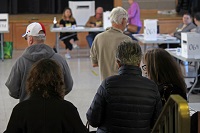

by Maurice Y. Michaud (he/him)
 Most Canadians alive today have always voted at the federal, provincial or territorial level using a single electoral method, namely the first-past-the-post (FPTP) system. To be elected in a general election, a person only has to win a relative majority of the votes in their race, and in a competitive multi-candidate race, it is very likely that this "relative majority" will be well below half the votes cast.
Most Canadians alive today have always voted at the federal, provincial or territorial level using a single electoral method, namely the first-past-the-post (FPTP) system. To be elected in a general election, a person only has to win a relative majority of the votes in their race, and in a competitive multi-candidate race, it is very likely that this "relative majority" will be well below half the votes cast.
Then, the political party having elected the most candidates is called upon to form a government in the legislative assembly for which the election was held. If that party obtained an absolute majority of winning candidates (50%+1), it will form what is known as a "majority" government. However, if the number of winners of all the other parties combined represents the absolute majority, the party with the relative majority of winners will instead form a "minority" government. Either way that party will take power, which is one of the reasons that leads some to refer to the FPTP system as one in which "the winner takes all."
Similarly, it was a vague and fluid notion in the 19th century in those jurisdictions where parties did not formally exist. Instead, candidates would declare themselves as supporting either "Government" or "Opposition," while others simply branded themselves as "Independent." In other words, they aligned themselves to the individual who either was or was not the head of government (or premier) when the election was being held. As such, if a general election yielded a plurality of "Opposition" winning candidates, they became the government after the election, but that allegiance to a given leader could change during the course of a legislature, sometimes leaving a handful of men at the helm of the government. This ostensibly consensual but confusing non-party system existed in British Columbia until 1903 and Manitoba until 1879. And while parties were not formally recognized in the New Brunswick legislature until 1935, party alignments similar to the federal level were used de facto in that province as early as 1878.
The following electoral systems have been or are used in Canada at the federal or provincial/territorial levels during general elections or by-elections. Quebec and the territories for which a legislative assembly was formed in the 20th century are the only jurisdictions to have used the FPTP system in all their elections, while all the other jurisdictions have used other systems in some elections, either exclusively or in combination with other systems.
Only Manitoba and Alberta have used a proportional system in some ridings, the other ridings using a majoritarian system like FPTP. Overall, the governments formed by these electoral hybrids were just as lopsided in favour of the winning political party, and the tabulation of the votes (at a time when computers did not exist) was tedious. It could at times take days before some winners could be declared.
| Electoral systems used in Canada, 1866–2024 | |||||||
|---|---|---|---|---|---|---|---|
| Jurisdiction | Years | FPTP | PAL | IR-AV | STV | ||
| 1 | CA |  |
1867–1968 1968–2024 |
✓ ✓ |
✓ |
|
|
| 9 | AB |  |
1905–1909 1909–1926 1926–1956 1956–2024 |
✓ ✓ ✓ |
✓ |
✓ |
✓ |
| 8 | BC |  |
1871–1952 1952–1956 1956–1991 1991–2024 |
✓ ✓ ✓ |
✓ ✓ |
✓ |
|
| 11 | MB |  |
1870–1920 1920–1927 1927–1958 1958–2024 |
✓ ✓ ✓ |
|
✓ |
✓ ✓ |
| 3 | NB |  |
1866–1874 1874–1895 1895–1912 1912–1948 1948–1967 1967–1974 1974–2024 |
✓ ✓ ✓ ✓ |
✓ ✓ ✓ ✓ ✓ ✓ |
|
|
| 7 | NL |  |
1949–1975 1975–2024 |
✓ ✓ |
✓ |
|
|
| 2 | NS |  |
1867–1933 1933–1981 1981–2024 |
✓ ✓ |
✓ ✓ |
|
|
| 14 | NT |  |
1951–2024 |
✓ |
|
|
|
| 13 | NU |  |
1999–2024 |
✓ |
|
|
|
| 6 | ON |  |
1867–1886 1886–1914 1914–2024 |
✓ ✓ ✓ |
✓ |
|
|
| 4 | PE* |  |
1873–1893 1893–1996 1996–2024 |
✓ ✓ |
✓ |
|
|
| 5 | QC |  |
1867–2024 |
✓ |
|
|
|
| 10 | SK |  |
1905–1917 1917–1967 1967–2024 |
✓ ✓ ✓ |
✓ |
|
|
| 12 | YT |  |
1970–2024 |
✓ |
|
|
|
| 15 | NW |  |
1888–1892 1892–1905 |
✓ ✓ |
✓ |
|
|
| * From 1893 to 1996, two members per riding were elected (Assemblyman and Councillor) | |||||||
Referendums in Canada have used other majoritarian systems, including one that requires a super global majority or a dual majority.
Variations of the following proportional system are used in many countries and has been proposed in several Canadian jurisdictions but ultimately never adopted:
Tabulating the results of an election conducted with a proportional system can be a bit more complicated than those from an FPTP or PAL election — certainly for an election using the STV method — but considering that such elections have been successfully conducted well before the easy access to computers, the argument that a proportional system is inherently "just too complicated" does not hold water given how a majoritarian system like alternative voting has already been used despite being really complicated.
Now the question must be asked: Could we change our electoral system... again?